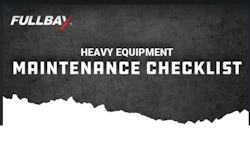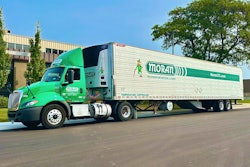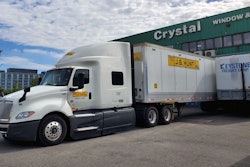Carriers are still steering through a tough economic landscape. Other factors also caused disruption, mainly the brief port strike and onset of Hurricane Helene and Hurricane Milton.
Fleets, such as Saia and XPO, however, have shown resilience making strategic moves to highlight their adaptability in the tough market.
Covenant reports modest revenue growth
Covenant (CCJ Top 250, No. 36) reported a 2.1% increase on its revenue, driven by new business growth in its dedicated segment, which partially offset by reductions from its expedited and managed freight segment. Despite a challenging environment, Chairman and CEO David Parker said that the company capitalized on new “value-added commercial opportunities” where available, and allocated equipment investments towards more profitable operations, and controlling costs.
The average age of its fleets as of September 30th improved to 20 months compared to 23 months a year ago. Its asset-based truckload operations grew its average tractor count by 169 units. Parker noted that it reflects the company’s priorities of “maintaining the average of our fleet in a manner that allows us to optimize operational uptime and related operating costs.”
Revenue: 2024 Q3: $287.8 million vs. 2023 Q3: $288.7 million
2024 YTD: $854 million vs. 2023 YTD: $829.5 million
Income: 2024 Q3: $13 million vs. 2023 Q3: $13.5 million
2024 YTD: $29.2 million vs. 2023 YTD: $42 million
-
Forward Air Corporation brings new COO to execute sales strategy
Though Forward Air Corporation (No. 31) saw revenue and income go up versus last year, with CEO Shawn Stewart noting that the company is focused on integration following its acquisition of Omni Logistics. “We expect that the magnitude and complexity of this integration will put us well into 2025 before it is substantially complete, and certain work streams may continue into 2026, but we will not lose our focus on the customer and their needs,” Steward said.
[RELATED: Forward Air investors call to initiate formal sales process]
The company’s expedited freight segment decreased in year-over-year revenue due to a volume-focused pricing strategy. In response, Forward Air is bringing in Eric Brandt, formerly an executive at CEVA Logistics, as Chief Commercial Officer in January.
Revenue: 2024 Q3: $655.9 million vs. 2023 Q3: $341 million
2024 YTD: $1.8 billion vs. 2023 YTD: $1 billion
Income: 2024 Q3: $22.7 million vs. 2023 Q3: $11.7 million
2024 YTD: $(1.13) billion vs. 2023 YTD: $85.2 million
-
Heartland Express reduces acquisition-related debt
Heartland Express (No. 25) reported a net loss of $9.3 million, with CEO Mike Gerdin saying this was caused by low freight demand and excess truck capacity and noted that the last four quarters since the end of 2022 was “the worst four consecutive quarters” the company has experienced.
Despite mishaps, the company has made headway in making operational improvements reducing acquisition-related debt from past acquisitions and newly acquired entities, Smith Transport and Contract Freighters, Inc.
As of September 2024, the average age of the company’s consolidated tractor fleet was 2.7 years, up from 1.9 years during the same period last year. The average age of the consolidated trailer fleet reached 7.2 years, compared to 6.2 years on the same date in 2023.
Revenue: 2024 Q3: $259.8 million vs. 2023 Q3: $295 million
2024 YTD: vs. $805 million 2023 YTD: $932 million
Income: 2024 Q3: $(9.3) million vs. 2023 Q3: $(10.7) million
2024 YTD: $(27.9) million vs. 2023 YTD: $(9.7) million
-
J.B. Hunt’s Integrated Capacity Solutions segment sees improvement
J.B. Hunt (No.3) saw declines in both profit (down 3%) and revenue (down 7%), though CEO Shelly Simpson said they see promising signs as demand returns to more typical seasonal patterns amid the challenging freight market.
Its Integrated Capacity Solutions segment reduced its operating loss to $(3.3) million, compared to $(9.4) million in Q3 2023, “driven by an $11.7 million increase in gross profit and lower cargo claims and personnel-related expenses, partially offset by integration and transition costs related to the purchase of the brokerage assets of BSNF Logistics,” the company said in its earnings release.
The company also underwent new executive changes, which Simpson said will “address the potential we see across the company as we move into 2025.”
Revenue: 2024 Q3: $3 billion vs. 2023 Q3: $3.16 billion
2024 YTD: $8.94 billion vs. 2023 YTD: $9.5 billion
Income: 2024 Q3: $224 million vs. 2023 Q3: $241.7 million
2024 YTD: $624 million vs. 2023 YTD: $789.9 million
-
Knight-Swift Transportation’s LTL segment makes its move to California
Knight-Swift’s (No. 4) revenue saw a 7.1% dip, whilst operating income saw a 0.4% increase compared to same quarter last year. The truckload segment’s revenue took a 6.1% decrease year-over-year, following the acquisition of U.S. Xpress. The LTL segment saw an increase in revenue (16.7% y/y) and shipments per day (11.1%), though startup costs and early-stage operations on its 16 new service centers caused adjusted operating income to decline (19.5%).
In an earnings call, CEO Adam Miller noted that the acquisition of LTL carrier Dependable Highway Express was a significant move to its expansion to California, Nevada and Arizona.
In its truckload segment, the average age of the tractor fleet was 2.6 years, compared to 2.5 years in the same quarter of 2023. In its LTL segment, the average age of the tractor fleet was 4.2 years in Q3 2024, and 4.3 years in the same period in 2023.
Revenue: 2024 Q3: $1.9 billion vs. 2023 Q3: $2 billion
2024 YTD: $5.5 billion vs. 2023 YTD: $5.2 billion
Income: 2024 Q3: $81.4 million vs. 2023 Q3: $81 million
2024 YTD: $165 million vs. 2023 YTD: 319.8 million
-
Landstar’s truck revenue per load beats seasonality
Amid a soft freight market, Landstar (No.10) saw its revenue decrease by 6%. Truck transportation revenue, which accounts for 90% of its revenue, saw a decline to $1.091 billion from $1.174 billion in Q3 2023.
Despite challenges, it achieved a 3.2% sequential increase in truck revenue per load compared to the 2024 second quarter, outperforming typical seasonality, CEO Frank Lonegro said in an earnings report. This was driven by a strong month-over-month truck revenue per load increase in July, but dwindling through August and September, in part due to tougher prior month comparisons.
Similar to Q2, Lonegro said in an earnings call that the company’s owner-operator headcount was down 12% year-over-year, driven by high operating costs, low rates, and lengthy waits for repairs.
Revenue: 2024 Q3: $1.21 billion vs. 2023 Q3: $1.28 billion
2024 YTD: $3.6 billion vs. 2023 YTD: $4 billion
Income: 2024 Q3: $63 million vs. 2023 Q3: $80 million
2024 YTD: $191 million vs. 2023 YTD: $269.5 million
-
Marten Transport showed significant declines in revenue and income
Marten Transport (No.37) reported significant decrease in net income (72.1%) and revenues (15.1%), influenced by high operating costs and freight rate reductions, said executive chairman Randolph Marten.
However, Marten added that it was the first quarter with sequential improvement in combined truckload and dedicated rate per total mile since the fourth quarter of 2022, after failing in Q1 and Q2. The carrier had also seen an increased interest by customers to secure dedicated capacity.
As of September 30, 2024, the carrier had a total of 3,080 tractors, compared 3,454 tractors in the same period last year. The average age of tractors were 1.8 years in both periods. Total trailers in September 2024 were 5,456, while in the same period last year, it was 5,726. The average age of trailers were 5.2 years versus 4.4 years last year.
In previous earnings reports, Marten noted the company’s refusal to take rate cuts since August 2023. This was not addressed in this quarter’s commentary.
Revenue: 2024 Q3: $237.4 million vs. 2023 Q3: $279.5 million
2024 YTD: $733.3 million vs. 2023 YTD: $863.2 million
Income: 2024 Q3: $4.3 million vs. 2023 Q3: $17.2 million
2024 YTD: vs. $26.5 million 2023 YTD: $74.5 million
-
Old Dominion Freight Line’s LTL services saw less freight, but offset with LTL revenue
Old Dominion Freight Line (No.9) saw a 3.0% decrease in its revenue, driven by a 4.8% decrease in LTL tons per day that was partially offset by a 1.5% increase in LTL revenue per hundredweight. Net income was down 9.1% compared to Q3 2023, impacted by decreased revenue and increased operating ratio, indicating higher operating expenses.
Marty Freeman, president and CEO of ODFL, credited the results to ongoing softness in the domestic economy. In contrast to the strong comparable results for the third quarter of 2023, it resulted in the first year-over-year decrease in its quarterly revenue and earnings.
Revenue: 2024 Q3: $1.47 billion vs. 2023 Q3: $1.5 billion
2024 YTD: $4.4 billion vs. 2023 YTD: $4.3 billion
Income: 2024 Q3: $308.5 million vs. 2023 Q3: $339.2 million
2024 YTD: $922.9 million vs. 2023 YTD: $916.6 million
-
P.A.M. Transportation Services feels impact of weak market and Hurricane Helene
P.A.M. Transportation Services (No. 58) total revenues was down 9.4% year-over-year, amid a weak truckload market and the impact of Hurricane Helene.“The quarter started off slow because of extended, but planned, downtime from some of our biggest customers and ended slower than expected as we saw impacts to our business and volumes prior to Hurricane Helene,” said Joe Vitiritto, president.
High operating costs continued to “materialize,” but Vitiritto said that the company is determined to “minimize the impact to our business and focus on factors that we can control.”
Operating ratio averaged at 102.8% in the first nine months of 2024, compared with 96% in the same period last year.
Revenue: 2024 Q3: $182.6 million vs. 2023 Q3: $201.5 million
2024 YTD: $548 million vs. 2023 YTD: $630 million
Income: 2024 Q3: $2.4 million vs. 2023 Q3: $6 million
2024 YTD: $(217) million vs. 2023 YTD: $20.6 million
-
Schneider National’s dedicated and intermodal segments show resilience
Schneider National (No.8) reported a flat year-over-year revenue of $1.2 billion revenue. Its truckload sector revenues were down by 1% due to lower network volumes, offset by growth in the dedicated segment. Logistics revenues also decreased by 4%, while intermodal saw a slight increase, driven by internal cost improvements.
Though the company expects to improve its fourth quarter performance, execs in the earnings call noted that market recovery was slower than expected and expected seasonality momentum wasn’t sustained.
Revenue: 2024 Q3: $1.31 billion vs. 2023 Q3: $1.35 billion
2024 YTD: $3.95 million vs. 2023 YTD: $4.12 million
Income: 2024 Q3: $30.6 million vs. 2023 Q3: 35.6 million
2024 YTD: $84.4 million vs. 2023 YTD: $211.1 million
-
Saia implements rate increase
Saia (No.19) saw its year-over-year results in the third quarter to reflect the “growth experienced since last summer,” said Fritz Holzgrefe, the company’s president. “Our third-quarter revenue of $842 million increased from last year’s third quarter by 8.6% and is a record for any third quarter in our company’s history.”
Earnings report showed that LTL shipments per workday increased 8.5%, along with a rise of 0.9% of revenue per shipment. Holzgrefe also added mixed headwinds from “softer industrial background” and the boost of the retail industry.
Following the carrier’s opening of 11 terminals during the quarter, the company implemented a 7.9% general rate increase on October 21, noted to counterbalance expenses related $1 billion in investments in 2024 and other costs.
Revenue: 2024 Q3: $842 million vs. 2023 Q3: $775 million
2024 YTD: $2.4 billion vs. 2023 YTD: $2.1 billion
Income: 2024 Q3: $92.7 million vs. 2023 Q3: $98.2 million
2024 YTD: $286 million vs. 2023 YTD: $266 million
-
UPS saw revenue increase
UPS (No.2) reported a 5.6% increase of consolidated revenue, reaching $22.2 billion, compared to the same period a year ago. The company also saw its highest year-over-year average daily volume growth rate in the US since Q1 2021, with a 6.5% increase.
After a tough 18-month period, UPS CEO Carol Tomé said that the company had returned to revenue and profit growth. “Peak season is nearly upon us, and we are ready to deliver another successful holiday season and continue the progress we demonstrated in the third quarter,” Tomé said.
Revenue: 2024 Q3: $22.2 billion vs. 2023 Q3: $21 billion
2024 YTD: $65.7 billion vs. 2023 YTD: $66 billion
Income: 2024 Q3 $1.5 billion: vs. 2023 Q3: $1.2 billion
2024 YTD: vs. $4 billion 2023 YTD: $5 billion
Werner braces for pricing and margin pressures
Werner (No.14) saw revenue down 9% and income up at 54%. Derek Leathers, Chairman and CEO noted that freight conditions proved to be a challenge, as well as hurricane-related supply chain disruptions at the end of the quarter.
“Pricing and margin pressures persist in logistics, and resale equipment values remain low,” Leathers said. “We continue to make structural changes, driving operating efficiencies, cost savings and advancing our technology roadmap. We continue to adapt to ever-changing conditions and remain focused on positioning Werner for strength and creating long-term value for our shareholders as conditions improve.”
Revenue: 2024 Q3: $745.7 million vs. 2023 Q3: $817.7 million
2024 YTD: $2.3 billion vs. 2023 YTD: $2.4 billion
Income: 2024 Q3: $17.6 million vs. 2023 Q3: $38 million
2024 YTD: $52.7 million vs. 2023 YTD: $138.4 million
-
XPO saw income rise due to pricing strategy
XPO (No.7) grew 3.7% in revenue, and 10.5% income. In its North American LTL operations, it grew adjust operating income by 17% and achieved an adjusting operating ratio of 84.2%. CEO Mario Harik explained, “We drove yield, ex-fuel, higher by 6.7% and increased revenue per shipment by 6.6%, underpinned by pricing gains. In addition, we generated stronger operating leverage on our top-line growth by managing variable costs more effectively with our proprietary technology. And we’re tracking three years ahead of plan with linehaul insourcing, which enhances our network efficiency and quality of service.”
Its European transportation segment also saw $803 million revenue in Q3 2024, compared with $752 million a year ago, primarily driven by volume growth.
Revenue: 2024 Q3: $2.05 billion vs. 2023 Q3: $1.98 billion
2024 YTD: $6.1 billion vs. 2023 YTD: $5.8 billion
Income: 2024 Q3: $95 million vs. 2023 Q3: $86 million
2024 YTD: $3123 million vs. 2023 YTD: $131 million












